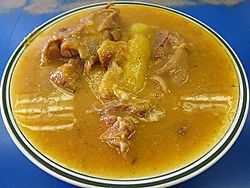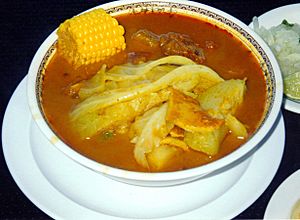Sopa de mondongo facts for kids

Puerto Rican-style sopa de mondongo
|
|
| Type | Soup |
|---|---|
| Region or state | Latin America, Caribbean, Maritime Southeast Asia |
| Main ingredients | Tripe, vegetables (bell peppers, onions, carrots, cabbage, celery, tomatoes) or root vegetables, cilantro (coriander), garlic |
Sopa de mondongo is a delicious and hearty soup! It's made from diced tripe, which is the stomach of a cow or pig, cooked slowly until it's super tender. This soup is packed with fresh vegetables like bell peppers, onions, carrots, cabbage, celery, and tomatoes. You'll also find yummy herbs like cilantro and garlic, or sometimes root vegetables. This popular dish is often eaten in countries that used to be Spanish colonies, especially in Latin America, the Caribbean, and the Philippines.
Contents
Different Ways to Make Mondongo
Many countries have their own special way of making sopa de mondongo. Sometimes, people add rice or maize (corn) towards the end of cooking. Some recipes might even use bone marrow for extra flavor! Before cooking, the tripe might be soaked in citrus juice or a special paste to make it even more tender. The vegetables and spices used can change depending on what's available in each place.
Mondongo in Argentina
In Argentina, this soup is simply called mondongo. It's a popular and filling meal.
Mondongo in Brazil
In Brazil, it's also known as mondongo or mocotó. People usually enjoy it in the southern parts of the country. In the northeast, there's a similar dish called dobradinha, which also uses tripe.
Mondongo in Colombia
In Colombia, sopa de mondongo is often served as the soup part of a traditional lunch, called almuerzo. The Colombian version often uses chicken or beef broth and lots of fresh cilantro. Many vegetables like peas, carrots, and onions are added to give the broth a rich taste. Salt, pepper, and corn are also common additions. While beef tripe is most typical, some regions also use pork, chicken, or turkey tripe in their soup.
Mondongo in Panama
In Panama, it's just called "mondongo." It's cooked like a stew with onions, carrots, chickpeas, and a bay leaf. It's often flavored with chorizo sausage or salted pigtails. This is considered a very filling meal, usually eaten with white rice. Other side dishes might include salads and sweet plantains. When a new house is being built in the countryside, the owners, their friends, family, and workers often have a special meal called a "mondongada," where mondongo is the main dish! There's a special version from the province of Colon called "mondongo a la culona" that includes pig knuckles and feet, and uses white beans instead of chickpeas.
Mondongo in Puerto Rico
In Puerto Rico, this soup is made with beef broth, chickpeas, corn, potatoes, sweet potatoes, squash, malanga, and carrots. It gets its flavor from sofrito (a mix of herbs and spices), tomato sauce, bay leaves, and annatto. Ham, salted pig feet, and tail are also sometimes added. Lime juice, green plantains, green bananas, capers, olives, and other root vegetables like cassava are very common too. People enjoy it with rice, fried plantains, avocado, bread, or hot sauce.
Mondongo in El Salvador
In El Salvador, this soup is also known as "sopa de pata" (foot soup) and is thought to be very nutritious and tasty. It's cooked with ripe bananas, cabbage leaves, cassava, sesame seeds, pumpkin seeds, carrots, potatoes, huisquil, green chili, udder or beef tripe, onion, and cow's feet.
Mondongo in Venezuela
In Venezuela, the dish is called mondongo, while the tripe itself is called "panza" (belly). It's considered a very heavy meal, often eaten as the only meal of the day. It's usually enjoyed in the north-central regions and in the Llanos. Depending on the region, it might be sweeter (like on the eastern coast) or include chickpeas. A common thing in almost all Venezuelan mondongo is adding pig feet to make the taste richer and add more calories. The mondongo is often flavored with lemon or tamarind and served with arepas or casabe (a type of flatbread). People in Venezuela often eat mondongo very early in the morning or late at night, especially after fun gatherings. You can also find mondongo sold in restaurants that specialize in arepas.


